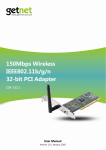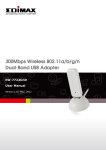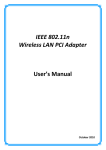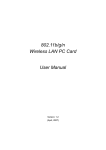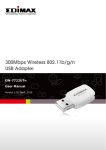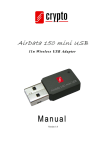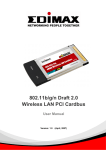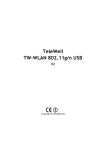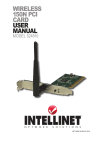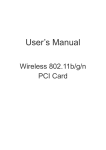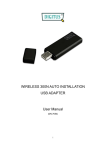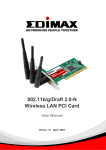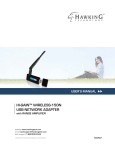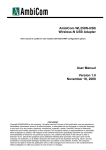Download Viewsonic WPD-100
Transcript
ViewSonic ® WPD-100 Wireless Presentation Dongle - User Guide Model No. : VS13789 Compliance Information For U.S.A. This device complies with part 15 of FCC Rules. Operation is subject to the following two conditions: (1) this device may not cause harmful interference, and (2) this device must accept any interference received, including interference that may cause undesired operation. This equipment has been tested and found to comply with the limits for a Class B digital device, pursuant to part 15 of the FCC Rules. These limits are designed to provide reasonable protection against harmful interference in a residential installation. This equipment generates, uses, and can radiate radio frequency energy, and if not installed and used in accordance with the instructions, may cause harmful interference to radio communications. However, there is no guarantee that interference will not occur in a particular installation. If this equipment does cause harmful interference to radio or television reception, which can be determined by turning the equipment off and on, the user is encouraged to try to correct the interference by one or more of the following measures: • Reorient or relocate the receiving antenna. • Increase the separation between the equipment and receiver. • Connect the equipment into an outlet on a circuit different from that to which the receiver is connected. • Consult the dealer or an experienced radio/TV technician for help. Warning: You are cautioned that changes or modifications not expressly approved by the party responsible for compliance could void your authority to operate the equipment. CE Conformity for European Countries The device complies with the EMC Directive 2004/108/EC and Low Voltage Directive 2006/95/EC. Following information is only for EU-member states: The mark shown to the right is in compliance with the Waste Electrical and Electronic Equipment Directive 2002/96/EC (WEEE). The mark indicates the requirement NOT to dispose the equipment as unsorted municipal waste, but use the return and collection systems according to local law. ViewSonic WPD-100 i FCC Radiation Exposure Statement This equipment should be installed and operated with minimum distance 20cm between the radiator & your body. This wireless module device complies with part 15 of FCC Rules. Operation is subject to the following two conditions: (1) this device may not cause harmful interference, and (2) this device must accept any interference received, including interference that may cause undesired operation. R&TTE Compliance Statement This device complies with the Essential Requirements of the R&TTE Directive of the European Union (1999/5/EC). This equipment meets the following conformance standards: ETSI EN 300 328 EN 301 489-01 EN 301 489-17 EN 50392 Notified Countries: Germany, UK, Netherlands, Belgium, Sweden, Denmark, Finland, France, Italy, Spain, Austria, Ireland, Portugal, Greece, Luxembourg, Estonia, Latvia, Lithuania, Czech Republic, Slovakia, Slovenia, Hungary, Poland and Malta. ViewSonic WPD-100 ii Declaration of RoHS Compliance This product has been designed and manufactured in compliance with Directive 2002/95/ EC of the European Parliament and the Council on restriction of the use of certain hazardous substances in electrical and electronic equipment (RoHS Directive) and is deemed to comply with the maximum concentration values issued by the European Technical Adaptation Committee (TAC) as shown below: Substance Proposed Maximum Concentration Actual Concentration Lead (Pb) 0,1% < 0,1% Mercury (Hg) 0,1% < 0,1% Cadmium (Cd) 0,01% < 0,01% Hexavalent Chromium (Cr6+) 0,1% < 0,1% Polybrominated biphenyls (PBB) 0,1% < 0,1% Polybrominated diphenyl ethers (PBDE) 0,1% < 0,1% Certain components of products as stated above are exempted under the Annex of the RoHS Directives as noted below: Examples of exempted components are: 1. Mercury in compact fluorescent lamps not exceeding 5 mg per lamp and in other lamps not specifically mentioned in the Annex of RoHS Directive. 2. Lead in glass of cathode ray tubes, electronic components, fluorescent tubes, and electronic ceramic parts (e.g. piezoelectronic devices). 3. Lead in high temperature type solders (i.e. lead-based alloys containing 85% by weight or more lead). 4. Lead as an allotting element in steel containing up to 0.35% lead by weight, aluminium containing up to 0.4% lead by weight and as a cooper alloy containing up to 4% lead by weight. ViewSonic WPD-100 iii Copyright Information Copyright © ViewSonic® Corporation, 2010. All rights reserved. ViewSonic®, the three birds logo, OnView®, ViewMatch™, and ViewMeter® are registered trademarks of ViewSonic® Corporation. Disclaimer: ViewSonic® Corporation shall not be liable for technical or editorial errors or omissions contained herein; nor for incidental or consequential damages resulting from furnishing this material, or the performance or use of this product. In the interest of continuing product improvement, ViewSonic® Corporation reserves the right to change product specifications without notice. Information in this document may change without notice. No part of this document may be copied, reproduced, or transmitted by any means, for any purpose without prior written permission from ViewSonic® Corporation. Product Registration To meet your future needs, and to receive any additional product information as it becomes available, please register your product on the Internet at: www.viewsonic.com. For Your Records Product Name: Model Number: Document Number: Serial Number: Purchase Date: WPD-100 Wireless Presentation Dongle VS13789 WPD-100_UG_ENG Rev. 1A 10-08-10 Product disposal at end of product life ViewSonic respects the environment and is committed to working and living green. Thank you for being part of Smarter, Greener Computing. Please visit ViewSonic website to learn more. USA & Canada: http://www.viewsonic.com/company/green/recycle-program/ Europe: http://www.viewsoniceurope.com/uk/support/recycling-information/ Taiwan: http://recycle.epa.gov.tw/recycle/index2.aspx ViewSonic WPD-100 iv CATALOG CHAPTER I: Product Information................................................................................. 1 1-1 Introduction and safety information....................................................................... 1 1-2 Safety Information ................................................................................................ 2 1-3 System Requirements .......................................................................................... 3 1-4 Package Contents ................................................................................................ 4 1-5 Familiar with WPD-100......................................................................................... 5 CHAPTER II: Driver Installation and Configuration.................................................... 6 2-1 WPD-100 Installation............................................................................................ 6 2-2 Connect to Wireless Access Point ........................................................................ 8 2-2-1 Using WPD-100 Utility................................................................................ 9 2-2-1-1 Scan for Other Wireless Devices ................................................... 10 2-2-1-2 Connect to an Access Point ........................................................... 15 2-2-1-3 Add an Access Point to Profile ....................................................... 17 2-2-2 Using Windows Zero Configuration.......................................................... 24 2-3 Advanced Settings.............................................................................................. 27 2-4 View Network Statistics....................................................................................... 28 2-5 WMM Setting ...................................................................................................... 28 2-6 WPS Configuration ............................................................................................. 30 2-6-1 WPS Setup - PBC (Push-Button Configuration)....................................... 31 2-6-2 WPS Setup - PIN ..................................................................................... 33 2-7 SSO.................................................................................................................... 34 2-8 CCX.................................................................................................................... 35 2-9 Radio On/Off....................................................................................................... 36 2-10 About ................................................................................................................ 36 2-11 On-line Help...................................................................................................... 37 CHAPTER III: Soft-AP Function.................................................................................. 38 3-1 Switch to AP Mode and Basic Configuration....................................................... 38 3-2 Security Setting .................................................................................................. 41 3-3 Access Control.................................................................................................... 43 3-4 Connection Table................................................................................................ 45 3-5 Event Log ........................................................................................................... 46 3-6 Statistics ............................................................................................................. 47 3-7 About .................................................................................................................. 47 3-8 Open Diagnostic Testing Mode........................................................................... 48 CHAPTER IV: Appendix .............................................................................................. 49 4-1 Specification ....................................................................................................... 49 4-2 Troubleshooting .................................................................................................. 50 ViewSonic WPD-100 CHAPTER I: Product Information 1-1 Introduction and safety information Thank you for purchasing ViewSonic WPD-100! Excepting common wireless standards 802.11b/g, it is also able to access 802.11n wireless networks - data transfer rate is 150Mbps, and that’s three times faster than 802.11g wireless network! With easy-to-install USB 2.0 interface - a very common expansion port of computers - plug WPD-100 into any empty USB port of your computer, just that simple! Other features of WPD-100 including: High-efficiency antenna expands the scope of your wireless network. High-speed data transfer rate - Up to 150Mbps. WMM function: control the bandwidth required for different applications. Work with 802.11b/g/Draft-N wireless networks. Supports major encryption methods like WEP, WPA, and WPA2 encryption. WPS - You don’t need an experienced computer technician to help you to get connected. Utilizing the software program of the WPD-100, you can get your computer connected by pushing a button or entering an 8-digit code. Pressing the button on the network card, the WPS connection can be activated as well. USB 2.0 interface - you can get it installed on your computer in just few seconds! ViewSonic WPD-100 1 1-2 Safety Information In order to keep the safety of users and your properties, please follow the following safety instructions: 1. This WPD-100 is designed for indoor use only. DO NOT expose it to direct sun light, rain, or snow. 2. DO NOT put WPD-100 at or near hot or humid places, like kitchen or bathroom. Also, do not left it in the car in summer. 3. This WPD-100 is small enough to put in a child’s mouth, and it could cause serious injury or could be fatal. If they throw the WPD-100, it will be damaged. PLEASE KEEP WPD-100 OUT THE REACH OF CHILDREN! 4. This WPD-100 will become hot when being used for long time (This is normal and is not a malfunction). DO NOT put it on a paper, cloth, or other flammable objects after long hours using. 5. There’s no user-serviceable part inside the WPD-100. If you found it is not working properly, please contact your dealer of purchase and ask for help. DO NOT disassemble by yourself. 6. If the WPD-100 falls into water, DO NOT USE IT AGAIN BEFORE YOU SEND IT BACK TO THE DEALER OF PURCHASE FOR INSPECTION. 7. If you smell something strange or even see some smoke coming out from WPD-100, switch the computer off immediately, and call dealer of purchase for help. ViewSonic WPD-100 2 1-3 System Requirements An empty USB 2.0 port (May not be able work with USB 1.1 port, and performance will be greatly reduced) Windows XP, Vista, or WIN7 operating system CD-ROM drive At least 100MB of available disk space ViewSonic WPD-100 3 1-4 Package Contents Before you starting to use WPD-100, please check if there’s anything missing in the package, and contact your dealer of purchase to claim for missing items: 1 - WPD-100 (1 pcs) 2 - Protection Cap (1 pcs) 3 - Quick Start Guide (1 pcs) 4 - CD (with Driver/Utility/User Manual (1 pcs) 2 1 4 3 ViewSonic WPD-100 4 1-5 Familiar with WPD-100 1. 2. 3. 4. USB Connector Connector Cap (To protect USB connector when not in use) Link/Activity LED WPS Button 3 1 2 4 LED Name Radio Off Radio On (No Link) Radio On (Link to AP or Router) Light Status Off Off Flashing On Description Wireless LAN function is disabled. No link to wireless AP or Router Transmitting management information. Link to wireless AP or Router Flashing Transmitting data or management information. ViewSonic WPD-100 5 CHAPTER II: Driver Installation and Configuration 2-1 WPD-100 Installation Please follow the following instructions to install WPD-100. 1. Insert the WPD-100 into an empty USB 2.0 port of your computer when computer is switched on. Never use force to insert the WPD-100, if you feel it’s stuck, flip it over and try again. 2. If the following message appears on your computer, please click ‘Cancel’. 3. Insert device driver CD into the CD/DVD ROM drive of your computer, and execute ‘Setup.exe’ program. Please read the end user license agreement and click ‘I accept the terms of the license agreement’ and ‘Next’ to accept license agreement. ViewSonic WPD-100 6 4. It is recommend installing driver and utility. If you want to update the driver only, choose ’Install driver only’. Click ‘Next’ to continue. 5. During the installation, you might see some security warning message vary by different systems, please ignore and click ‘Install this driver software anyway” to complete the installation. Note: Please disable firewall or anti-virus program before the installation. 6. Please wait while the install procedure is running. When you see this message, please click ‘Finish’ to complete the installation process. ViewSonic WPD-100 7 2-2 Connect to Wireless Access Point After the driver is correctly installed, you could use the utility to connect a specific wireless access point you wish to connect. The current status of wireless connection will be displayed by WPD-100 utility icon: Wireless connection is established, good signal reception. Wireless connection is established, normal signal reception. Wireless connection is established, weak signal reception. Connection is not established yet. Wireless network card is not detected. There are two ways you can configure your wireless network card to connect to wireless access point: using the WPD-100 utility or built-in windows zero configuration utility. ViewSonic WPD-100 8 2-2-1 Using WPD-100 Utility Please follow the following instructions to use WPD-100 utility to connect to wireless access point. 1. Right-click the WPD-100 utility icon located at lower-right corner of computer desktop and then clicks ‘Launch Config Utility’. 2. WPD-100 utility will launch, and begin to scan for all wireless access points automatically. Menu Setup Area More / Less button WPD-100 consists two parts: Menu and setup area. You can select a setup function (Profile, Network, etc.) from menu, and corresponding setup items will be displayed at setup area. Some function includes more information, and can not be fitted in setup area. In this case, you can click ‘More / less’ button to expand the setup utility window, to display more information: You can click ‘More / Less’ button again, and setup utility window will resume to its original size. Tip: If a setup item requires more information to complete the setup procedure, the setup utility window will expand automatically. ViewSonic WPD-100 9 2-2-1-1 Scan for Other Wireless Devices There are two kinds of wireless connection mode: Infrastructure and Ad-Hoc. Infrastructure mode is used by wireless access points, which is able to establish wireless connection for you and other wireless / wired network clients. Ad-Hoc mode is also know as ‘point-to-point’ mode, and in this mode, wireless devices such as computer or PDA will not be capable to establish wireless connection with more than one wireless device, and is suitable for establishing a one-to-one wireless connection between two wireless devices. Before you can connect to any wireless access point or device by infrastructure or Ad-Hoc mode, there two things you must know: a. Wireless device’s ‘SSID’ (Service Set IDentifier, someone will call it ‘access point’s name’). You can scan for the SSID of other wireless devices nearby, but if the SSID of the wireless device you wish to connect is hidden, you must know exact SSID before you can establish connection with it. b. If the wireless device you wish to connect uses encryption, you must know its encryption key. ViewSonic WPD-100 10 Please launch WPD-100 setup utility and it will scan for wireless access points near by: Scan results will be displayed here, please check if the wireless device (access point or another computer) with the SSID you wish to connect is shown here. Scan result includes 6 types of information, they are: A B C D E A The SSID (Service Set Identifier) of wireless device. If nothing is displayed here, it means the SSID of this wireless device is hidden. symbol appears in front of the name of wireless device, means If a you’ve established connected with that wireless device. B The type of this wireless device and the channel number of this wireless device. Means this wireless device is an access point Means this wireless device is a computer (Ad-Hoc mode, point-to-point connection) C The wireless standard supported by this access point is displayed here. ViewSonic WPD-100 11 ‘n’ for 802.11n WPS icon , ‘g; for 802.11g , and ‘b’ for 802.11b . will appear when the access point supports WPS. If the access point uses encryption, a key icon will appear. Note: When the access point supports WPS and WPS icon you will not see the key icon encryption. is appeared, here even through the access point uses D Shows the signal strength of access point by percentage. E Shows the bar graph of the signal strength. If you can not see the access point you wish to connect here, please click ‘Rescan’ button to scan for access point again, until the one you preferred is displayed. You may have to click ‘Rescan’ for more than two times before you can see the access point you wish to use here. If you still can not see the access point you wish to use after clicking ‘Rescan’ for more than five times, please move your computer closer to the location where the wireless access point is, or see instructions in Chapter 4-2 ‘Troubleshooting’. If you wish to see detailed information for a specific access point, please double-click on it, and you’ll be provided with its detailed information. ViewSonic WPD-100 12 There are 4 types of technical information: General: Displays basic information about this access point, such as SSID, MAC Address, authentication / encryption type, channel etc. WPS: If this access point supports WPS (Wi-Fi Protected Setup), related information will be displayed here. CCX: If this access point supports CCX (Cisco Compatible eXtension), related information will be displayed here. 802.11n: If this access point complies with 802.11n draft, related information will be displayed here. ViewSonic WPD-100 13 And here are descriptions of every setup item in setup area: Item Name Sorted by >> Show dBm Rescan Add to Profile Connect Description You can decide how to sort all listed access point by ‘SSID’, ‘Channel’, or ‘Signal’ (signal strength). Check this box to show the signal strength of access point, instead of percentage. Click this button to rescan access points. You can click this button for several times, if the access point you wish to use does not show in the list. You can store a specific access point to profile, so you can link to that access point directly next time, without inputting authentication key again. To add an access point to profile, you have to select an access point from the list first, then click ‘Add to Profile’ button. Detailed instructions will be given below. Connect to a selected access point. You have to select an access point from the list first and then click ‘Connect’ to connect to the selected access point. ViewSonic WPD-100 14 2-2-1-2 Connect to an Access Point If the wireless access point you wish to connect is found, you can establish connection with it by clicking ‘Connect’ button. Instructions will be given as follow: 1. Click the wireless access point or network device you wish to connect, it will be highlighted, then click ‘Connect’. If the access point you selected does not use encryption, you’ll be connected to this wireless access point within one minute. If the access point you selected uses encryption, please proceed to step 3. 2. If the wireless access point does not have SSID, you’ll be prompted to input it now. Please ask the owner of wireless access point for the exact SSID and input it here, then click ‘OK’ when ready. If the SSID you provided here is wrong, you’ll not be able to connect to this access point. 3. If the wireless access point uses encryption, you will be prompted to input its WEP key or WPA preshared key. ViewSonic WPD-100 15 4. Please ask the owner of the wireless access point you want to connect, and input the correct key here and then click ‘OK’. If the value you inputted here is wrong, you will not be able to connect to this wireless access point. Authentication type will be selected by the authentication type of the access point automatically, please don’t change it. However, if you’re connecting to an access point uses 802.1x authentication, you have to check ‘802.1x’ box and input related information. Instructions for 802.1x authentication will be given later. 5. If the wireless access point is successfully connected, you’ll see a symbol appears in front of the name of wireless device. You can put the mouse cursor over the WPD-100 utility icon, and the brief information about link status and signal strength of current wireless connection will be shown as a popup balloon. You can also click More / Less button ( of connected access point: ViewSonic WPD-100 ) to see detailed information 16 2-2-1-3 Add an Access Point to Profile If you will connect to some specific wireless access point frequently, you can add their information to the profile. Just like the telephone directory, the profile saves all information of access points, and you can recall them anytime you wish to establish connection. You can add a found access point to profile, or access to Profile section to input all information of an access point by yourself. ViewSonic WPD-100 17 Here are descriptions of every setup item: Item Name Profile Name SSID Network Type Tx Power Preamble Channel Description You can give this profile a name. Every profile needs a unique name. Please input the SSID of this access point. If you selected an access point from the list, and its SSID is not hidden, the SSID will be filled automatically; however, you can modify the SSID by yourself. Please select the network type: Ad hoc or Infrastructure. If you’re connecting to an access point, please select ‘Infrastructure’; for point-to-point wireless connection (i.e. connecting to another computer using Ad Hoc mode), please select Ad hoc here. If you selected an access point from the list above, please keep this field unchanged. You can select the wireless output power here. If you’re not too far from access point (good signal reception), you can select a lower output power to save energy; for a distant access point, you can select a higher output power. It’s suggested to select ‘Auto’ to let setup utility decide the best output power for you. Select the preamble for Ad hoc mode here. Available options are ‘Auto’ and ‘Long’. It’s suggested to select ‘Auto’ to let setup utility decide the preamble for you. You can select the radio channel number for AdHoc mode here. ViewSonic WPD-100 18 Power Save Mode RTS Threshold Fragment Threshold Please select CAM (constantly awake mode, keep wireless radio activity even when not transferring data), or PSM (Power saving mode, switches radio off when not transferring data). It’s recommended to choose ‘PSM’ if you’re using this network card with notebook computer to help the battery live longer. Check this box to set the RTS threshold by yourself. You can drag the slider to set the threshold value, or input the value in the box located at right. It’s recommended to keep this value untouched unless you know the effect of changing this value. Check this box to set the packet fragment threshold by yourself. You can drag the slider to set the threshold value, or input the value in the box located at right. It’s recommended to keep this value untouched unless you know the effect of changing this value. ViewSonic WPD-100 19 To set authentication / encryption information for the access point. Please click ‘Auth. \ Encry.’ tab: Here are descriptions of every setup item: Item Name Description Authentication Select the authentication type of the wireless access point or wireless device you wish to connect. When you’re adding a profile from an existing access point or wireless device, authentication type will be selected automatically, and please do not change it. Encryption Select the encryption type of the wireless access point or wireless device you wish to connect. When you’re adding a profile from an existing access point or wireless device, the encryption type will be selected automatically, and please do not modify it. WPA Input WPA preshared key here. If encryption is not enabled, Preshared or you select ‘WEP’ as encryption type, this field will be Key disabled and grayed out. WEP Key You can select key type (Hexadecimal or ASCII) and input WEP key here. If encryption is not enabled, or you select ‘WPA’ as encryption type, this field will be disabled and grayed out. You can set up to 4 WEP keys here. There are two types of WEP key: Hexadecimal and ASCII. For Hexadecimal key, you can input number 0-9 and alphabet a-f; for example, ‘001122aabbcc’; For ASCII key, you can input number 0-9 and alphabet a-z; for example, mywepkey12345. ViewSonic WPD-100 20 Use 802.1x The length of WEP key depends on the type of WEP key you selected. You can input 10 or 26 hexadecimal characters and 5 or 13 ASCII characters as WEP key. If the access point you wish to connect requires 802.1x authentication, please click on ‘Use 802.1x’ box, then click ‘802.1X’ tab to set 802.1x parameters. To set 802.1x authentication for the access point. Please click ‘802.1X’ tab: Here are descriptions of every setup item: Item Name EAP Method Description Select 802.1x EAP method from dropdown menu. Please ask the administrator of the access point you wish to connect to select a correct EAP method. Tunnel Select 802.1x tunnel authentication type from dropdown Authentication menu. Please ask the administrator of the access point you wish to connect to select a correct tunnel authentication method. This pull down menu is only available when authentication type you use is 'PEAP', ‘TLS / Smart Card', or 'TTLS'. When you use 'EAP-FAST' as authentication type, the protocol setting is always 'Generic Token Card' and can not be changed. You also need to select ‘Soft Token’ or ‘Static Password’ as password in ‘ID \ Password’ setting. ’EAP Fast’ authentication type also have a sub-menu to set EAP fast-specific parameters: ViewSonic WPD-100 21 If you need to use protected authentication credential, check ‘Use protected authentication credential’ box, and click ‘Import’ to load .pac credential file; to remove a loaded credential file, click ‘Remove’. Session You can enable or disable session resumption here. If you Resumption don’t know if you should enable session resumption or not, please ask your 802.1x authentication administrator. ID \ Password Input 802.1x username (ID) and password and other tab information if it is required here. Click ‘Show Password’ to show the password you typed. Client Use this tab to select a local certificate from dropdown Certification menu. If the access point you wish to connect required a tab specific client certificate, the certificate must be installed on your computer, and you can select the certificate here. Server Use this tab to use server-based certification. Please select Certification a CA (Certificate Authority) from dropdown menu. If tab intermediate certificates are allowed, please select ‘Allow intermediate certificates’. Also, if you need to specify CA server’s name, you can specify it in ‘Server name’ field. You can select ‘Server name must match’, so the CA server’s name must be the same with the value you set in ‘Server name’ field; If only the domain name part of full server name must the same with the value you set in ‘Server name’ field, select ‘Domain name must end in specified name’. After you complete all information related to the access point, click ‘OK’ to save the profile, or click ‘cancel’ to cancel adding a new profile. If the profile is created, you will see the information in the Profile List. ViewSonic WPD-100 22 Here are descriptions of Profile List item: Item Name Add Edit Delete Import Export Activate Description Click to create a new profile. Edit existed profile. Delete existed profile if the profile is no longer to be used. Import existed profile from your computer to WPD-100 utility. Export the selected profile and store in your computer. Activate a specific wireless device in the profile list. A icon will be displayed if the connection is failed; If the icon will be connection is successfully established, a displayed. ViewSonic WPD-100 23 2-2-2 Using Windows Zero Configuration Windows XP and Vista has a built-in wireless network configuration utility, called as ‘Windows Zero Configuration’ (WZC). You can also use WZC to configure your wireless network parameter: 1. Right-click WPD-100 utility icon and select ‘Use Zero Configuration as Configuration utility’. 2. Right click Windows Zero Configuration icon and select ‘View Available Wireless Networks’. If you can not find the icon, please follow the procedures from step 3 to step 5. 3. Go to ‘Control Panel’ and access to ‘Network and Internet Connections’. 4. Click ‘Network Connections’. 5. Right-click ‘Wireless Network Connection’ (it may have a number as suffix if you have more than one wireless network card, please make sure you right-click the ‘ViewSonic WPD-100 Wireless LAN Card), then select ‘View Available Wireless Networks’. ViewSonic WPD-100 24 6. All wireless access points in proximity will be displayed here. If the access point you want to use is not displayed here, please try to move your computer closer to the access point, or you can click ‘Refresh network list’ to rescan access points. Click the access point you want to use if it’s shown, then click ‘Connect’. 7. If the access point is protected by encryption, you have to input its security key or passphrase here. It must match the encryption setting on the access point. If the access point you selected does not use encryption, you’ll not be prompted for security key or passphrase. ViewSonic WPD-100 25 8. If you can see ‘Connected’ message, the connection between your computer and wireless access point is successfully established. ViewSonic WPD-100 26 2-3 Advanced Settings This wireless network card provides several advanced settings for experienced wireless users. Here are descriptions of every setup item: Item Name Description Wireless mode Display the wireless operation mode of the network card. Enable Tx Burst Check this box to accelerate the data transmit rate. It may not work with all wireless access point and wireless devices. Enable TCP Check this box and the configuration utility will adjust Window Size TCP window size automatically to get better performance. It should be safe for most of wireless environments, but if you found some problem on data transfer, uncheck this box. Fast Roaming Check this box and you can control the threshold that the wireless network card should switch to another wireless access point with better signal quality. Only adjust value when you understand what it means and you need to roam between multiple access points. Show When your computer is being authenticated by wireless Authentication authentication server, a dialog window with the process Status Dialog of authentication will appear. This function is helpful to find out the problem when you can not be authenticated, and you can provide this information to authentication server’s administrator for debugging purpose. After you finish the settings, click ‘Apply’ to apply new settings. ViewSonic WPD-100 27 2-4 View Network Statistics This section provides information about network statistics and link status. All connection-related statistics is displayed here. You can click ‘Transmit’ or ‘Receive’ tab, to view the statistics of transmitted or received packets. You can also click ‘Reset Counter’ button, to reset the statistics of all items back to 0. 2-5 WMM Setting This wireless network card provides WMM (Wi-Fi Multimedia) function, which can improve the performance of certain network applications, like audio/video streaming, network telephony (VoIP), and others. When you enable the WMM function of this network card, you can define the priority of different kinds of data, to give higher priority to applications which require instant responding. Therefore you can improve the performance of such network applications. ViewSonic WPD-100 28 In ‘WMM Setup Status’ block, current WMM settings will be displayed. And here are descriptions of every setup item: Item Name WMM Enable WMM - Power Save Enable Description Check this box to enable WMM function. Please click ‘Apply’ button on the right of this check box after you check or uncheck this box, so corresponding settings in this window will be activated or deactivated respectively. Check this box to enable WMM power saving mode to save energy, and let your computer’s battery live longer. You also have to select WMM power save modes here: Direct Link Setup Enable AC_BE: Best Performance AC_BK: Worst Performance AC_VI: Video data has priority AC_VO: Voice data has priority If you have another WMM-enabled wireless device, you can enter its MAC address here, then click ‘Apply’ button, and this network card will establish a direct link to the wireless device you specified here. You also have to specify the timeout value of this directly-linked wireless device. Valid values are from 1 to 65535 (seconds), and input ‘0’ for infinity. If you want to remove a specific wireless device from direct link table, select the device and click this button to remove it. ViewSonic WPD-100 29 2-6 WPS Configuration Wi-Fi Protected Setup (WPS) is the latest wireless network technology which makes wireless network setup become very simple. If you have WPS-enabled wireless access point, and you want to establish a secure connection to it, you don’t have to configure the wireless access point and setup data encryption by yourself. All you have to do is to go to the WPS setup page of this wireless card, click a button, and then press a specific button or enter a set of 8-digit code on the wireless access point you wish to establish a secure connection just three simple steps! For older wireless access points, it’s possible to perform a firmware upgrade to become a WPS-enabled access point. Since they may not have a hardware button to press for WPS setup, you can use an alternative WPS setup method - input the pin code. Every WPS-compatible wireless network card support pin code configuration method; you can just input the code to wireless access point, and the wireless access point and wireless network card will do the rest for you. This wireless network card is compatible with WPS. To use this function, the wireless access point you wish to connect to must support WPS function too. ViewSonic WPD-100 30 2-6-1 WPS Setup - PBC (Push-Button Configuration) 1. Set ‘Config Mode’ to ‘Enrollee’, and then push the ‘WPS’ button on your wireless access point (the button used to activate WPS standby mode may have another name), or use other way to start WPS PBC standby mode as the instruction given by your wireless access point’s user manual. You can also set ‘Config Mode’ to ‘Registrar’. In this mode, this wireless network card will wait for other WPS-enabled access points to send WPS pairing requests. Please refer to the instruction given by your wireless access point’s user manual to understand how to send WPS requests. 2. Before you start to establish the wireless connection by using WPS, you can click ‘Rescan’ button to search for WPS-enabled access points near you again, to make sure the WPS function of your access point is activated. All access points with WPS function enabled will be displayed here. Please make sure the access point you wish to connect is displayed. If not, please click ‘Rescan’ few more times. You can also click ‘Information’ button to see the detailed information about selected access point. ViewSonic WPD-100 31 3. Start PBC pairing procedure at access point side (please refer to the instruction given by your access point’s manufacturer), then click ‘PBC’ button in wireless configuration utility to start to establish wireless connection by WPS. Please be patient (This may take a period to complete). When you see ‘WPS status is connected successfully’ message, means the connection between this wireless network card and access point is successfully established by WPS, and the information about access point you connected to will be displayed. 4. You can click ‘Detail’ button to see detailed information of connected access point. If you wish to save this connection as a profile, you can click ‘Export Profile’ button, and this connection will be saved. You can find this connection in ‘Profile’ tab in a later time. 5. Sometime WPS may fail because no WPS-enabled access point is found. If it happens, you can click ‘PBC’ button few more times to try again. 6. When an access point is connected, you can click ‘Disconnect’ to disconnect your wireless network card from a connected access point, or select another WPS-enabled wireless access point, then click ‘Connect’ to establish connection to selected access point, if there are more than one WPS-enabled access point found. You can also click ‘Rotate’ button, and next access point on the list will be selected to establish connection. 7. If you want to delete a found access point from the list, select it and click ‘Delete’ button. ViewSonic WPD-100 32 2-6-2 WPS Setup - PIN If the wireless access point you wish to connect supports PIN, please follow the following instructions to establish connection to it: 1. The PIN code of your wireless network card is an eight-digit number located at the upper-right position of the utility. Remember it, and input the number to your wireless access point as the WPS PIN code (Please refer to the user manual of your wireless access point for instructions about how to do this). NOTE: If you experienced problem with the pin code provided here, you can click ‘Renew’ to get a new pin code. 2. Click ‘PIN’ button now, and wait for few seconds to one minute. If a wireless access point with correct PIN code is found, you’ll be connected to that access point. 3. If not, you may have to click ‘PIN’ for few more times to try again. If you still can not connect to access point by this way, please make sure the PIN code you provided to access point is correct. ViewSonic WPD-100 33 2-7 SSO Single sign-on (SSO) is a property of access control of multiple, related, but independent software systems. With this property a user logs in once and gains access to all systems without being prompted to log in again at each of them. Here are descriptions of every setup item: Enable SSO Choose which SSO methods to log on. 1. Use ID and Password in Winlogon. 2. Use ID and Password in Profile. 3. User ID and Password in Dialog. Enable Pre-Logon Connectivity User ID and Password in the previous activated Profile and not show any authentication dialog. Profile List (only support LEAP or 1. Select Profile: Select a profile EAP-Fast authentication) containing LEAP or EAP-Fast authentication. 2. Information of selected profile: Profile information such as profile name, SSID. ViewSonic WPD-100 34 2-8 CCX CCX is a wireless feature developed by Cisco used to improve the wireless performance with CCX compatible wireless devices. Here are descriptions of every setup item: Enable CCX 1. Enable Radio Measurements: When you’re connecting to CCX-compatible access point, check this box to enable radio measurement function to improve wireless connectivity. Non-Serving Channel Measurements Limit is between 0 to 1023 milliseconds. 3. Roaming with RF Parameters: Roaming by a set of RF parameters from AP. 4. Voice Drastic Roaming: Diagnose roaming function by voice traffic test. 5. CAC: Enable the call admission control. 6. Diagnostic: Select a profile which the user wants to diagnose, then hit the Diagnose button to perform the diagnostic test. ViewSonic WPD-100 35 2-9 Radio On/Off You can switch the wireless radio transceiver on and off by the utility, so if you want to disable wireless network function, you don’t have to remove the network card physically. Wireless radio is on (Green) Wireless radio is off (Red) 2-10 About The ‘About’ tab provides you the information about version number of the WPD-100 utility, driver, and other important information about your wireless network card. ViewSonic WPD-100 36 2-11 On-line Help If you need to know the directions of how to use specific function in the utility, please click ‘Help’ button. On-line help documents will be presented in Windows help format. Click this button to view on-line help documents. ViewSonic WPD-100 37 CHAPTER III: Soft-AP Function Excepting become a wireless client of other wireless access points, this wireless card can act as a wireless service provider also! You can switch this wireless card’s operating mode to ‘AP’ mode to simulate the function of a real wireless access point by software, and all other computers and wireless devices can connect to your computer wirelessly, even share the internet connection you have! Please follow the instructions in following chapters to use the AP function of your wireless card. 3-1 Switch to AP Mode and Basic Configuration The operating mode of the wireless card is ‘Station Mode’ (becoming a client of other wireless access points) by default. If you want to switch to AP mode, please right-click WPD-100 utility icon, and select ‘Switch to AP Mode’. If you want to switch the wireless card back to station mode, click ‘Switch to Station Mode’. There is basic configuration menu of the AP function. ViewSonic WPD-100 38 Here are descriptions of every setup item: Item Name SSID Description Please input the SSID (the name used to identify this wireless access point) here. Up to 32 numerical characters can be accepted here, excepting space. Channel Please select the wireless channel you wish to use. The number of channels available here will vary depends on the setting of ‘Country Region Code’. Wireless Mode Select the operation mode of the access point here. Use Mac Address Click this button to use the MAC address of the wireless card as SSID. A prefix ‘AP’ will be added automatically. Security Setting Set the security options (wireless data encryption). Please refer to chapter 3-2 ‘Security Settings’ for details. Country Region Please select the country code of the country or region Code you live. Available options are 0-7, which will affect the available wireless channels you can use: 0: FCC (US, Canada, and other countries uses FCC radio communication standards) 1: ETSI (Europe) ViewSonic WPD-100 39 2: SPAIN 3: FRANCE 4: MKK 5: MKKI (TELEC) 6: ISERAL (Channel 3 to 9) 7: ISERAL (Channel 5 to 13) No forwarding among wireless clients Hide SSID Please note that only change the country code if you are in different country. For example: when operating this product in US, only channels 1~11 can be operated. Selection of other channels is not permitted under FCC regulations. Check this box and wireless clients will not be able to share data with each other. Check this box and the SSID will not be broadcasted to the public. Your wireless clients must know the exact SSID to be able to connect to your computer. This option is useful to enhance security level. Allow BW 40 MHz Check this box to allow BW 40MHz capability. Beacon(ms) You can define the time interval that a beacon signal should be send. Default value is 100. Do not modify this value unless you know what will be affected. TX Power You can select the wireless output power here. Please select a proper output power setting according to your actual needs. You may not need 100% of output power if other wireless clients are not far from you. Idle Time Select the idle time for the wireless access point. Default value is 300. Do not modify this value unless you know what will be affected. To save changes, click ‘Apply button. Or you can click ‘Default’ to reset all values to factory default value. ViewSonic WPD-100 40 3-2 Security Setting This wireless card supports wireless encryption in AP mode, which will encrypt the data being transferred over the air to enhance data security level. It’s recommended to enable data encryption unless you wish to open your computer (and its internet connection) to the public. When you click ‘Security Setting’ in the utility, the following window will appear: Here are descriptions of every setup item: Item Name Authentication Type Encryption Type Description Please select a wireless authentication type you wish to use. Available options are ‘Open’, ‘Shared’, WPA-PSK’, ‘WPA2-PSK’, and ‘WPA-PSK / WPA2-PSK’. If you want to disable wireless data encryption, you must select ‘Open’. Please select an encryption mode. The available options in this setting item will vary depending on the authentication type you select. If you select ‘Not Use’, ViewSonic WPD-100 41 WPA Pre-shared Key Group Rekey Interval Wep Key data will not be encrypted and people with some networking knowledge will be able to read the data you transfer with proper tool. Please input the WPA pre-shared key here. Only clients with the same pre-shared key you inputted here will be able to connect to your computer. This setting is only available when you select one of WPA encryptions. You can specify the time interval to re-issue the key to your wireless clients here. You can click the button ’10 seconds’ or ‘Kpackets’ to change the unit of time interval. (every 10 seconds or a thousand data packets times the value you specified in ‘Group Rekey Interval’ field). Please input the WEP encryption key here when you select ‘WEP’ as encryption type. There are 2 types of WEP key: Hex (number 0 to 9, and ASCII characters A to F) and ASCII (all alphanumerical characters plus symbols). Please select the type of WEP key first, and then input the WEP key according to the type of WEP key you selected. If you want to use WEP 64 bits encryption, please input 10 characters if you select HEX, or input 5 characters if you select ASCII. If you want to use WEP 128bits encryption, please input 26 characters if you select HEX, or input 13 characters if you select ASCII. 128 bits encryption is safer then 64 bits, but the data transfer speed will be slightly reduced. When you finish with setting and want to save changes, click ‘OK’ button, or click ‘Cancel’ button to discard all changes you made. ViewSonic WPD-100 42 3-3 Access Control If you’re not going to open your computer and wireless resources to the public, you can use MAC address filtering function to enforce your access control policy, so only wireless clients with MAC address you defined by this function can be connected to your software access point. Here are descriptions of every setup item: Item Name Access Policy Description Select the policy type of your access rule. Disable: Allow any wireless client with proper authentication settings to connect to this access point. Allow All: Only allow wireless clients with MAC address listed here to connect to this access point. ViewSonic WPD-100 43 MAC address Add Delete Remove All Reject All: Reject wireless clients with MAC address listed here to be connected to this access point. Input the MAC address of the wireless client you wish to allow or reject here. No colon (:) or hyphen (-) required. Add the MAC address you inputted in ‘MAC address’ field to the list. Please select a MAC address from the list, then click ‘Delete’ button to remove it. Delete all MAC addresses in the list. When you finish with setting and want to save changes, click ‘Apply’ button. ViewSonic WPD-100 44 3-4 Connection Table If you want to see the list of all wireless clients connected to this access point, please select ‘Mac Table’ tab from the utility. Here are descriptions of every field: Item Name MAC Address AID Power Saving Mode Status Description Displays the MAC address of this wireless client. The serial number of this wireless connection. Displays the capability of power-saving function of this wireless client. Displays additional information of this wireless Connection, like current wireless operating mode and data transfer rate. ViewSonic WPD-100 45 3-5 Event Log This software access point will log all wireless-related activities as a log. Click ‘Event Log’ tab, and the event log will be displayed. You can click ‘Clear’ to remove all entries in the log. ViewSonic WPD-100 46 3-6 Statistics If you want to know detailed information about how your software access point works, click ‘Statistics’ tab, and the event log will be displayed. You can click ‘RESET COUNTERS’ button to reset all counters to zero. 3-7 About The ‘About’ tab provides you the information about version number of the configuration utility, driver, and other important information about your wireless access point. ViewSonic WPD-100 47 3-8 Open Diagnostic Testing Mode The function is to check if utility, driver, and network all work fine. ViewSonic WPD-100 48 CHAPTER IV: Appendix 4-1 Specification Standards: IEEE 802.11b/g Interface: USB 2.0 (USB 1.1 Compatible) Frequency Band: 2.4000 ~ 2.4835GHz (Industrial Scientific Medical Band) Data Rate: 11b: 1/2/5.5/11Mbps 11g: 6/9/12/24/36/48/54Mbps 11n (20MHz): MCS0-7 (up to 72Mbps) 11n (40MHz): MCS0-7 (up to 150Mbps) Securities: WEP 64/128, WPA, WPA2 Cisco CCX Support Drivers: Windows XP/Vista/WIN7 ViewSonic WPD-100 49 4-2 Troubleshooting If you encounter any problem when you’re using this wireless network card, don’t panic! Before you call your dealer of purchase for help, please check this troubleshooting table, the solution of your problem could be very simple, and you can solve the problem by yourself! Scenario Solution I can’t find any wireless 1. Click ‘Rescan’ for few more times and see if you access point / wireless can find any wireless access point or wireless device in ‘Site Survey’ device. function. 2. Please move closer to any known wireless access point. 3. ‘Ad hoc’ function must be enabled for the wireless device you wish to establish a direct wireless link. 4. Please adjust the position of network card (you may have to move your computer if you’re using a notebook computer) and click ‘Rescan’ button for few more times. If you can find the wireless access point or wireless device you want to connect by doing this, try to move closer to the place where the wireless access point or wireless device is located. Nothing happens when 1. Please make sure the wireless network card is I click ‘Launch Config inserted into your computer’s USB port. If the Utility’ WPD-100 utility’s icon is black, the network card is not detected by your computer. 2. Reboot the computer and try again. 3. Remove the card and insert it into another USB port. 4. Remove the driver and re-install. 5. Contact the dealer of purchase for help. I can not establish 1. Click ‘Connect’ for few more times. connection with a 2. If the SSID of access point you wish to connect certain wireless access is hidden (nothing displayed in ‘SSID’ field in point ‘Site Survey’ function), you have to input correct SSID of the access point you wish to connect. Please contact the owner of access point to ask for correct SSID. ViewSonic WPD-100 50 The network is slow / having problem when transferring large files 3. You have to input correct security key to connect an access point with encryption. Please contact the owner of access point to ask for correct security key. 4. The access point you wish to connect only allows network cards with specific MAC address to establish connection. Please go to ‘About’ tab and write the value of ‘Phy_Addess’ down, then present this value to the owner of access point so he / she can add the MAC address of your network card to his / her access point’s list. 1. Move closer to the place where access point is located. 2. Disable ‘Tx Burst’ in ‘Advanced’ tab. 3. Enable ‘WMM’ in ‘WMM’ tab if you need to use multimedia / telephony related applications. 4. Disable ‘WMM – Power Save Enable’ in ‘WMM’ tab. 5. There could be too much people using the same radio channel. Ask the owner of the access point to change the channel number. Please try one or more solutions listed above. ViewSonic WPD-100 51 Customer Support For technical support or product service, see the table below or contact your reseller. NOTE: You will need the product serial number. T = Telephone F = FAX Email Australia/New Zealand www.viewsonic.com.au AUS= 1800 880 818 NZ= 0800 008 822 [email protected] Canada www.viewsonic.com T (Toll-Free)= 1-866-463-4775 T (Toll)= 1-424-233-2533 F= 1-909-468-3757 [email protected] Europe www.viewsoniceurope.com www.viewsoniceurope.com/uk/support/call-desk/ Hong Kong www.hk.viewsonic.com T= 852 3102 2900 [email protected] India www.in.viewsonic.com T= 1800 11 9999 [email protected] Ireland (Eire) www.viewsoniceurope.com/uk/ www.viewsoniceurope.com/uk/ support/call-desk/ [email protected] Korea www.kr.viewsonic.com T= 080 333 2131 [email protected] Latin America (Argentina) www.viewsonic.com/la/ T= 0800-4441185 [email protected] Latin America (Chile) www.viewsonic.com/la/ T= 1230-020-7975 [email protected] Latin America (Columbia) www.viewsonic.com/la/ T= 01800-9-157235 [email protected] Latin America (Mexico) www.viewsonic.com/la/ T= 001-8882328722 [email protected] Country/Region Website Renta y Datos, 29 SUR 721, COL. LA PAZ, 72160 PUEBLA, PUE. Tel: 01.222.891.55.77 CON 10 LINEAS Electroser, Av Reforma No. 403Gx39 y 41, 97000 Mérida, Yucatán. Tel: 01.999.925.19.16 Other places please refer to http://www.viewsonic.com/la/soporte/index.htm#Mexico Latin America (Peru) www.viewsonic.com/la/ T= 0800-54565 [email protected] Macau www.hk.viewsonic.com T= 853 2870 0303 [email protected] Middle East ap.viewsonic.com/me/ Contact your reseller [email protected] Puerto Rico & Virgin Islands www.viewsonic.com T= 1-800-688-6688 (English) T= 1-866-379-1304 (Spanish) F= 1-909-468-3757 [email protected] [email protected] Singapore/Malaysia/ Thailand www.ap.viewsonic.com T= 65 6461 6044 [email protected] South Africa ap.viewsonic.com/za/ Contact your reseller [email protected] United Kingdom www.viewsoniceurope.com/uk/ www.viewsoniceurope.com/uk/ support/call-desk/ [email protected] United States www.viewsonic.com T (Toll-Free)= 1-800-688-6688 T (Toll)= 1-424-233-2530 F= 1-909-468-3757 [email protected] ViewSonic WPD-100 52 Limited Warranty Please go to the Customer Support table in this guide for the ViewSonic website in your region to get warranty information. ViewSonic WPD-100 53




























































